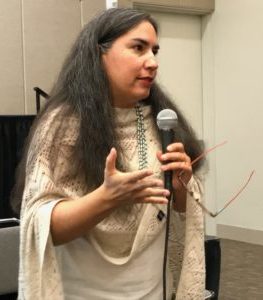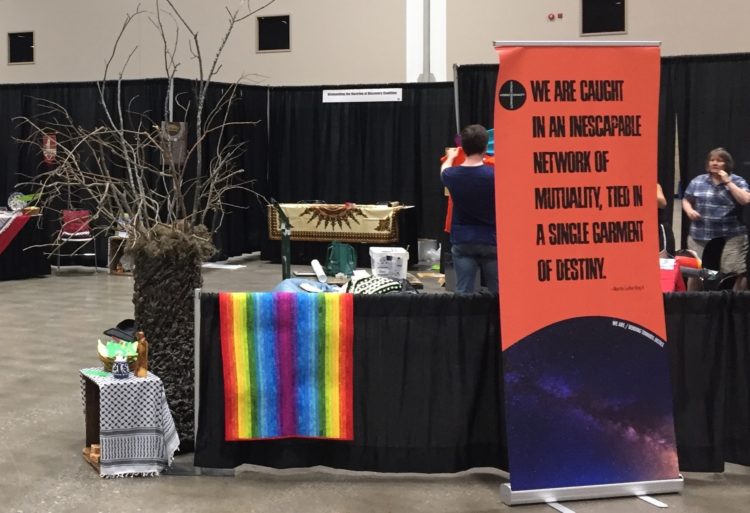By Jennifer Schrock
Compared to previous years, the Mennonite Church USA’s biennial convention July 2 to 6 had fewer workshops about specific issues such as land care, sustainable agriculture and greening your congregation. Rather, creation care came up in multiple settings in discussions about intersectional justice.
The word, intersectionality, has been around since 1989 when Kimberle’ Williams Crenshaw, an African-American law professor, coined it in relation to the multiple forms of oppression women of color face. The Merriam-Webster Dictionary, which first included intersectionality in 2017, defines it as, “the complex, cumulative manner in which the effects of different forms of discrimination combine, overlap, or intersect.”
Whatever the layers of meaning intersectionality has acquired in the media in recent years, at MennoCon19, it involved a deep sadness about our complicity in unjust systems that seem too big to change. In response, people expressed a desire for a shared vision uniting and strengthening our various causes.
Journey Forward: What does the Mennonite peace witness look like today?
Mennonite Creation Care Network was invited to send a representative to the Journey Forward Peace Gathering before the convention. I attended on our behalf. Doug Kaufman attended as well, representing the Center for Sustainable Climate Solutions.
Catherine Barnes, who led the Journey Forward process that took place at the MCUSA convention in Orlando in 2017, was the moderator. In one exercise, we participated in a form of speed dating in which participants from backgrounds ranging from homelessness to women’s issues to climate change had the chance to describe their work to each other. I swapped stories about MCCN’s solar grants with someone working on gun violence.
In later discussions, we noted that the definition of peace-making “has expanded in a zillion areas.” The use of the term, violence, continues to broaden to include emotional violence, violence to the earth and equitable sharing of resources.
This made it difficult to answer the question, “What is our collective peace witness?” The group I was in found they could not do better than, “Pursuing God’s shalom.” They found the biblical concept of shalom inclusive of many forms of peacemaking while carrying less political baggage than other vocabulary. The drawback was that this explicitly Jewish/Christian language may not communicate in secular settings.
“If something is standing in the way of God’s shalom, we need to build coalitions together and realize we’re working for the same thing,” Del Hershberger, Hesston, Kans., remarked, putting the afternoon in a nutshell.
Living at peace with creation came up throughout the day. One comment came from Steve Thomas, Goshen, Ind., who is beginning a degree in forestry after a long career as a pastor. “Ecology has something to teach us in our work,” he said. “We need to cooperate with the land and see what will emerge without imposing our will. We can remove what is invasive and see what re-emerges.”
Connecting climate change and Indigenous rightsd
 A workshop entitled, Declaration of Solidarity with Indigenous Peoples illustrated the way seemingly competing causes intertwine and have common roots. The title of the workshop came from a document the Mennonite World Conference (MWC) General Council approved in April 2018. Through member denominations such as the Iglesia Evangelica Unida Hermanos Menonitas in Panama, MWC is directly connected to Indigenous groups whose land is being usurped.
A workshop entitled, Declaration of Solidarity with Indigenous Peoples illustrated the way seemingly competing causes intertwine and have common roots. The title of the workshop came from a document the Mennonite World Conference (MWC) General Council approved in April 2018. Through member denominations such as the Iglesia Evangelica Unida Hermanos Menonitas in Panama, MWC is directly connected to Indigenous groups whose land is being usurped.
Sarah Augustine of White Swan, Wash., led the workshop. Sarah is the co-founder of Suriname Indigenous Health Fund and the director of the Dispute Resolution Center of Yakima and Kittitas Counties. She has also brokered negotiations between mines and Indigenous Peoples. For Augustine, the connection between immigration issues, Indigenous rights and climate change is obvious.
“The immigration issue in the U.S. is rooted in removal of Indigenous Peoples from their lands for the purposes of extraction,” Augustine said. She described how Indigenous Peoples all over the world are struggling to retain their land which has become more desirable to mining companies in the past decade. Advances in technology have made it easier and more profitable to access remote lands in rain forests and deserts.
“Extractive industries are what cause climate change. I call it the death machine,” Augustine said. “Indigenous Peoples are the first people impacted by that. They are the indicator species.”
Sharing a tree of prayers
In the exhibit hall, the Mennonite Creation Care Network booth occupied a lively and colorful corner. On one side of us, the young adults with the Center for Sustainable Climate Solutions were helping visitors make tempestry bracelets that illustrated the rise in global temperatures. On the other side, several organizations collaborated to create a thirst for justice that connects the concerns of disadvantaged people of all sorts.
The Mennonite Palestine-Israel Network, the Mennonite Jewish Relations Working Group, Dismantling the Doctrine of Discovery, the Brethren Mennonite Council for LGBT Interests and Christian Peacemaker Teams were among the groups that shared space together to promote interactions. At the entrance to the alcove, the collaborators had created a tree. Visitors were invited to write a prayer for peace on a paper leaf and fasten it to a branch. The tree rapidly filled with peace prayers of all sorts, from the personal to the communal to the global.
More on intersectional justice
Panama Mennonites Request Prayer for Land Struggle
A 2015 article from Mennonite World Conference.
Climate Justice Impossible Without Racial and Economic Justice
The first in a series of articles Sojourners is doing on the intersectionality of climate change.
The Intersectionality Wars
This article from Vox describes Kimberle’ Williams Crenshaw’s thinking and provides socio-cultural background.

Above, a group of organizations that focused on the connections between justice issues prepare their joint exhibit for MennoCon19. The tree on the left looks barren in this photo, but visitors rapidly filled it with paper leaves containing prayers for peace. The prayers ranged from the personal to the communal to the global. Photo by Tim Nafziger.
